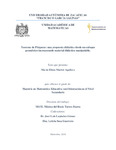
Please use this identifier to cite or link to this item:
http://ricaxcan.uaz.edu.mx/jspui/handle/20.500.11845/1229Full metadata record
| DC Field | Value | Language |
|---|---|---|
| dc.contributor | 773784 | es_ES |
| dc.contributor.advisor | Mónica del Rocío Torres Ibarra | es_ES |
| dc.contributor.author | José Luis Lupiañez Gómez | es_ES |
| dc.contributor.author | Leticia Sosa Guerrero | es_ES |
| dc.coverage.spatial | Durango, México | es_ES |
| dc.creator | Martos Aguilera, Maria Elena | - |
| dc.date.accessioned | 2019-10-23T15:38:09Z | - |
| dc.date.available | 2019-10-23T15:38:09Z | - |
| dc.date.issued | 2018-12-01 | - |
| dc.identifier | info:eu-repo/semantics/publishedVersion | es_ES |
| dc.identifier.uri | http://ricaxcan.uaz.edu.mx/jspui/handle/20.500.11845/1229 | - |
| dc.description | The design of a didactic proposal aimed at third grade students of secondary school (students between 12 and 15 years old), whose objective is the understanding of the Pythagorean Theorem based on the geometric demonstration of it, is carried out; After reviewing the bibliography we realized that one of the current problems in the teaching - learning of mathematics is that students memorize and repeat formulas, without finding a complete understanding of the meaning of them. Likewise, we take as theoretical support the Theory of Didactic Situations so that students through their phases can create their own knowledge because it is a teaching model focused on the production of mathematical learning and of course to base the proposal on cognitive, epistemological dimensions and didactic that allow us to contemplate the fundamental mathematical objects, as well as the errors and difficulties reported in the investigations, in order to articulate a geometric treatment of the Theorem with the use of manipulable teaching material, which together allow us to achieve understanding by of the students, therefore, the Didactic Engineering is used to validate and implement the proposal. Within the main results, we can say that the role of the teacher-researcher and the didactic material were crucial for the realization and application of the proposal, but above all, to guide the learning in the students, because thanks to these, to the Theory and Methodology the students managed to appropriate learning. | es_ES |
| dc.description.abstract | Se realiza el diseño de una propuesta didáctica dirigida a alumnos de tercer grado de secundaria (alumnos entre 12 y 15 años), que tiene por objetivo la comprensión del Teorema de Pitágoras sustentada en la demostración geométrica del mismo; tras la revisión de bibliografía nos percatamos que uno de los problemas actuales en la enseñanza aprendizaje de las matemáticas es que los alumnos memorizan y repiten fórmulas, sin encontrar una completa comprensión del significado de las mismas. Asimismo, tomamos como sustento teórico la Teoría de Situaciones Didácticas para que los alumnos a través de sus fases puedan ir creando su propio conocimiento pues es un modelo de enseñanza centrado en la producción de aprendizajes matemáticos y desde luego fundamentar la propuesta en dimensiones cognoscitivas, epistemológicas y didácticas que nos permitan contemplar los objetos matemáticos fundamentales, así como los errores y dificultades reportados en las investigaciones, con la finalidad de articular un tratamiento geométrico del Teorema con el uso de material didáctico manipulable, que en conjunto nos permitan lograr la comprensión por parte de los estudiantes por lo tanto, se utiliza la Ingeniería Didáctica para validar e implementar la propuesta. Dentro de los principales resultados, podemos decir que el papel de la profesora- investigadora y el material didáctico fueron cruciales para la realización y aplicación de la propuesta, pero sobre todo, para guiar el aprendizaje en los alumnos, pues gracias a éstos, a la Teoría y Metodología los alumnos lograron apropiarse del aprendizaje. | es_ES |
| dc.language.iso | spa | es_ES |
| dc.publisher | Universidad Autónoma de Zacatecas | es_ES |
| dc.relation.isbasedon | Maestría en Matemática Educativa con Orientación en el Nivel Secundaria | es_ES |
| dc.relation.uri | generalPublic | es_ES |
| dc.rights | Atribución-NoComercial-CompartirIgual 3.0 Estados Unidos de América | * |
| dc.rights.uri | http://creativecommons.org/licenses/by-nc-sa/3.0/us/ | * |
| dc.subject.classification | HUMANIDADES Y CIENCIAS DE LA CONDUCTA [4] | es_ES |
| dc.subject.other | Teorema de Pitágoras | es_ES |
| dc.subject.other | Comprensión | es_ES |
| dc.subject.other | Geometría | es_ES |
| dc.subject.other | Material Didáctico | es_ES |
| dc.title | Propuesta Didáctica: El Teorema de Pitágoras desde un enfoque geométrico incorporando material didáctico manipulable | es_ES |
| dc.type | info:eu-repo/semantics/masterThesis | es_ES |
| Appears in Collections: | *Tesis*-- UA Matemáticas | |
Files in This Item:
| File | Description | Size | Format | |
|---|---|---|---|---|
| 2018 Martos, M.E..pdf | Tesis de Martos 2018 | 7,51 MB | Adobe PDF |  View/Open |
This item is licensed under a Creative Commons License
